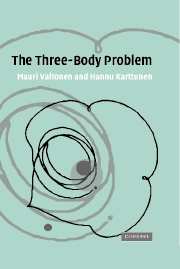Book contents
- Frontmatter
- Contents
- Preface
- 1 Astrophysics and the three-body problem
- 2 Newtonian mechanics
- 3 The two-body problem
- 4 Hamiltonian mechanics
- 5 The planar restricted circular three-body problem and other special cases
- 6 Three-body scattering
- 7 Escape in the general three-body problem
- 8 Scattering and capture in the general problem
- 9 Perturbations in hierarchical systems
- 10 Perturbations in strong three-body encounters
- 11 Some astrophysical problems
- References
- Author index
- Subject index
1 - Astrophysics and the three-body problem
Published online by Cambridge University Press: 04 December 2009
- Frontmatter
- Contents
- Preface
- 1 Astrophysics and the three-body problem
- 2 Newtonian mechanics
- 3 The two-body problem
- 4 Hamiltonian mechanics
- 5 The planar restricted circular three-body problem and other special cases
- 6 Three-body scattering
- 7 Escape in the general three-body problem
- 8 Scattering and capture in the general problem
- 9 Perturbations in hierarchical systems
- 10 Perturbations in strong three-body encounters
- 11 Some astrophysical problems
- References
- Author index
- Subject index
Summary
About the three-body problem
The three-body problem arises in many different contexts in nature. This book deals with the classical three-body problem, the problem of motion of three celestial bodies under their mutual gravitational attraction. It is an old problem and logically follows from the two-body problem which was solved by Newton in his Principia in 1687. Newton also considered the three-body problem in connection with the motion of the Moon under the influences of the Sun and the Earth, the consequences of which included a headache.
There are good reasons to study the three-body gravitational problem. The motion of the Earth and other planets around the Sun is not strictly a two-body problem. The gravitational pull by another planet constitutes an extra force which tries to steer the planet off its elliptical path. One may even worry, as scientists did in the eighteenth century, whether the extra force might change the orbital course of the Earth entirely and make it fall into the Sun or escape to cold outer space. This was a legitimate worry at the time when the Earth was thought to be only a few thousand years old, and all possible combinations of planetary influences on the orbit of the Earth had not yet had time to occur.
Another serious question was the influence of the Moon on the motion of the Earth.
- Type
- Chapter
- Information
- The Three-Body Problem , pp. 1 - 19Publisher: Cambridge University PressPrint publication year: 2006
- 1
- Cited by

